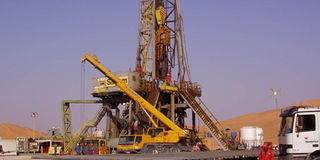Early pilot scheme is vital for production of Kenya’s crude oil

Oil drilling in northern Kenya. PHOTO/FILE.
What you need to know:
- The early oil pilot scheme is an enabler and not a replacement of full field development, which will include the Lamu Port Southern Sudan-Ethiopia Transport Corridor and a crude oil pipeline from Turkana to Lamu carrying between 80,000 and 150,000 barrels of oil a day.
- The pilot scheme will allow the operators to identify and manage risks associated with large capital-intensive development and so, reduce potential delays.
- The scheme will also provide an opportunity for both the national and county governments to gain the necessary experience and capabilities.
The past four years have been the most remarkable since oil and gas exploration started in Kenya in the early 1940s. During this period, 45 exploration wells have been drilled, more than the number drilled since the 1940s.
At the same time, Kenya has undertaken extensive policy, legal, and institutional reforms in line with the Constitution of Kenya 2010.
This review has seen Parliament’s approval of the Petroleum Bill 2015, the Community Land Bill 2015, and the Energy Bill 2015.
These Bills set out the industry’s regulatory structure and ensure that it is managed in a transparent and equitable manner, with all production-sharing agreements ratified by Parliament.
The Bills also ensure the protection of the environment and local community participation, and also provide a framework for managing the fiscal opportunities and risks of oil revenues expected once commercial production begins.
The government, in collaboration with the Turkana county government and the Kenya Joint Venture Partners — Tullow Oil, Africa Oil, and Maersk Oil — is working on the Early Oil Pilot Scheme, which will produce oil from five wells, with phase one targeting 2,000 barrels a day.
The oil will be transported from Turkana to Mombasa by road in insulated tanktainers.
Trucking of oil by road is widely practised in the world, for example in the United States, Canada, India, Russia, and Kazakhstan. At current oil prices, the scheme is not expected to generate significant revenue.
MAJOR MILESTONE
The project that most resembles Kenya’s is the Cairn India oil project. The crude oil produced at the Rajasthan fields is currently transported in the world’s longest continuously heated pipeline. Before the pipeline was built, Cairn India transported between 20,000 and 30,000 barrels of crude oil a day by road, over 750 kilometres, to the port at Kandla.
The early oil pilot scheme is an enabler and not a replacement of full field development, which will include the Lamu Port Southern Sudan-Ethiopia Transport Corridor and a crude oil pipeline from Turkana to Lamu carrying between 80,000 and 150,000 barrels of oil a day.
Although small-scale, the scheme will mark the first major milestone in Kenya’s oil and gas industry, producing and exporting crude oil for the first time in the country’s history.
So, why the pilot scheme? First, it will be key in establishing logistical and technical infrastructure and other arrangements crucial for supporting full field development.
This will allow the operators to identify and manage risks associated with large capital-intensive development and so, reduce potential delays. The scheme will also provide an opportunity for both the national and county governments to gain the necessary experience and capabilities.
Second, the scheme will provide important technical well data for planning for full field development.
This is also known as the appraisal phase. It is necessary to produce more crude oil to understand the reservoirs better and increase Kenya’s recoverable reserves from the current 750 million barrels to over 1 billion barrels
BUILD CAPABILITIES
Third, the scheme will help establish Kenya as a crude oil exporter and provide valuable information on the international market for Kenyan crude. It will help introduce the oil to the market in a low-key way and provide an understanding of what potential buyers are prepared to pay for it.
Finally, the scheme will create employment and business opportunities and build the capabilities of local business in anticipation of full field development.
Therefore, the scheme is an important technical project that will be a key enabler for full field development, which is still years away.
Although the scheme will not immediately solve the challenges in Turkana, it will be a stimulus for tackling them. For example, the government has allocated Sh3.2 billion for the tarmacking of the road from Eldoret to Lokichar and will fund a modern 600 kilometre highway from Eldoret to Nadapal.
The section between Lochuma and Nadapal (including Kainuk bridge) has secured financing from the World Bank. This will open up Turkana county to trade and tourism.
The government recognises that the development of a successful oil and gas industry that will benefit current and future generations requires broad and concerted efforts by all relevant stakeholders.
Mr Kamau is principal secretary, Department of Petroleum, Ministry of Energy and Petroleum. [email protected].




